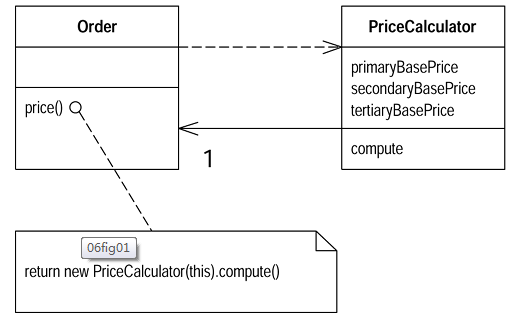你有一个大型函数,其中对局部变量的使用,使你无法釆用 Extract Method。
将这个函数放进一个单独对象中,如此一来局部变量就成了对象内的值域(field) 然后你可以在同一个对象中将这个大型函数分解为数个小型函数。
class Order...
double price() {
double primaryBasePrice;
double secondaryBasePrice;
double tertiaryBasePrice;
// long computation;
...
}
动机(Motivation)
我在本书中不断向读者强调小型函数的优美动人。只要将相对独立的代码从大型函数中提炼出来,就可以大大提高代码的可读性。
但是,局部变量的存在会增加函数分解难度。如果一个函数之中局部变量泛滥成灾, 那么想分解这个函数是非常困难的。Replace Temp with Query 可以助你减轻这一负担,但有时候你会发现根本无法拆解一个需要拆解的函数。这种情况下,你应该把手深深地伸入你的工具箱(好酒沉瓮底呢),祭出函数对象(method object )[Beck]这件法宝。
Replace Method with Method Object 会将所有局部变量都变成函数对象(method object)的值域(field)。然后你就可以对这个新对象使用 Extract Method 创造出新函数,从而将原本的大型函数拆解变短。
作法(Mechanics)
我厚着脸皮从Kent Beck [Beck]那里偷来了下列作法:
| · | 建立一个新class,根据「待被处理之函数」的用途,为这个class命名。 |
| · | 在新class中建立一个final值域,用以保存原先大型函数所驻对象。我们将这个值域称为「源对象」。同时,针对原(旧)函数的每个临时变量和每个参 数,在新中建立一个个对应的值域保存之。 |
| · | 在新class中建立一个构造函数(constructor),接收源对象及原函数的所有参数作为参数。 |
| · | 在新class中建立一个compute()函数。 |
| · | 将原(旧)函数的代码拷贝到compute()函数中。如果需要调用源对象的任何函数,请以「源对象」值域调用。 |
| · | 编译。 |
| · | 将旧函数的函数本体替换为这样一条语句:「创建上述新的一个新对象, 而后调用其中的compute()函数」。 |
现在进行到很有趣的部分了。由于所有局部变量现在都成了值域,所以你可以任意分解这个大型函数,不必传递任何参数。
范例(Example)
如果要给这一重构手法找个合适例子,需要很长的篇幅。所以我以一个不需要长篇幅(那也就是说可能不十分完美)的例子展示这项重构。请不要问这个函数的逻辑是什么,这完全是我且战且走的产品。
Class Account
int gamma (int inputVal, int quantity, int yearToDate) {
int importantValue1 = (inputVal * quantity) + delta();
int importantValue2 = (inputVal * yearToDate) + 100;
if ((yearToDate - importantValue1) > 100)
importantValue2 -= 20;
int importantValue3 = importantValue2 * 7;
// and so on.
return importantValue3 - 2 * importantValue1;
}
为了把这个函数变成一个函数对象(method object),我首先需要声明一个新class。在此新class中我应该提供一个final值域用以保存原先对象(源对象);对于函数的每一个参数和每一个临时变量,也以一个个值域逐一保存。
class Gamma...
private final Account _account;
private int inputVal;
private int quantity;
private int yearToDate;
private int importantValue1;
private int importantValue2;
private int importantValue3;
按惯例,我通常会以下划线作为值域名称的前缀。但为了保持小步前进,我暂时先保留这些值域的原名。
接下来,加入一个构造函数:
Gamma (Account source, int inputValArg, int quantityArg, int yearToDateArg) {
_account = source;
inputVal = inputValArg;
quantity = quantityArg;
yearToDate = yearToDateArg;
}
现在可以把原本的函数搬到compute()了。函数中任何调用Account class的地方,我都必须改而使用_account值域:
int compute () {
importantValue1 = (inputVal * quantity) +_account.delta();
importantValue2 = (inputVal * yearToDate) + 100;
if ((yearToDate - importantValue1) > 100)
importantValue2 -= 20;
int importantValue3 = importantValue2 * 7;
// and so on.
return importantValue3 - 2 * importantValue1;
}
然后,我修改旧函数,让它将它的工作转发〔委托,delegate)给刚完成的这个函 数对象(method object):
int gamma (int inputVal, int quantity, int yearToDate) {
return new Gamma(this, inputVal, quantity, yearToDate).compute();
}
这就是本项重构的基本原则。它带来的好处是:现在我可以轻松地对compute()函数采取 Extract Method,不必担心引数(argument)传递。
int compute () {
importantValue1 = (inputVal * quantity) + _account.delta();
importantValue2 = (inputVal * yearToDate) + 100;
importantThing();
int importantValue3 = importantValue2 * 7;
// and so on.
return importantValue3 - 2 * importantValue1;
}
void importantThing() {
if ((yearToDate - importantValue1) > 100)
importantValue2 -= 20;
}
























 被折叠的 条评论
为什么被折叠?
被折叠的 条评论
为什么被折叠?








